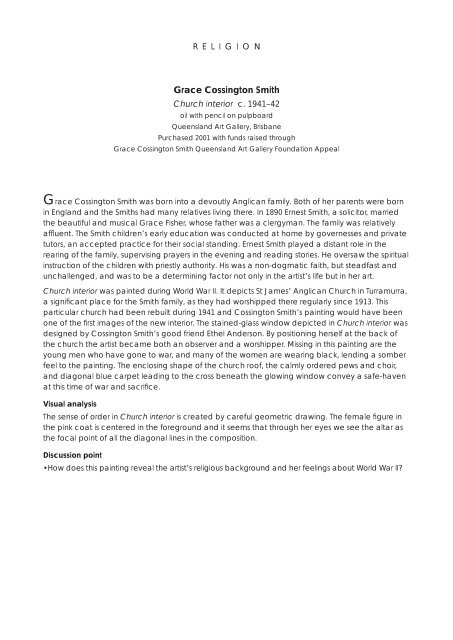Grace Cossington Smith - National Gallery of Australia
Grace Cossington Smith - National Gallery of Australia
Grace Cossington Smith - National Gallery of Australia
Create successful ePaper yourself
Turn your PDF publications into a flip-book with our unique Google optimized e-Paper software.
RELIGION<br />
<strong>Grace</strong> <strong>Cossington</strong> <strong>Smith</strong><br />
Church interior c. 1941–42<br />
oil with pencil on pulpboard<br />
Queensland Art <strong>Gallery</strong>, Brisbane<br />
Purchased 2001 with funds raised through<br />
<strong>Grace</strong> <strong>Cossington</strong> <strong>Smith</strong> Queensland Art <strong>Gallery</strong> Foundation Appeal<br />
<strong>Grace</strong> <strong>Cossington</strong> <strong>Smith</strong> was born into a devoutly Anglican family. Both <strong>of</strong> her parents were born<br />
in England and the <strong>Smith</strong>s had many relatives living there. In 1890 Ernest <strong>Smith</strong>, a solicitor, married<br />
the beautiful and musical <strong>Grace</strong> Fisher, whose father was a clergyman. The family was relatively<br />
affl uent. The <strong>Smith</strong> children’s early education was conducted at home by governesses and private<br />
tutors, an accepted practice for their social standing. Ernest <strong>Smith</strong> played a distant role in the<br />
rearing <strong>of</strong> the family, supervising prayers in the evening and reading stories. He oversaw the spiritual<br />
instruction <strong>of</strong> the children with priestly authority. His was a non-dogmatic faith, but steadfast and<br />
unchallenged, and was to be a determining factor not only in the artist’s life but in her art.<br />
Church interior was painted during World War II. It depicts St James’ Anglican Church in Turramurra,<br />
a signifi cant place for the <strong>Smith</strong> family, as they had worshipped there regularly since 1913. This<br />
particular church had been rebuilt during 1941 and <strong>Cossington</strong> <strong>Smith</strong>’s painting would have been<br />
one <strong>of</strong> the fi rst images <strong>of</strong> the new interior. The stained-glass window depicted in Church interior was<br />
designed by <strong>Cossington</strong> <strong>Smith</strong>’s good friend Ethel Anderson. By positioning herself at the back <strong>of</strong><br />
the church the artist became both an observer and a worshipper. Missing in this painting are the<br />
young men who have gone to war, and many <strong>of</strong> the women are wearing black, lending a somber<br />
feel to the painting. The enclosing shape <strong>of</strong> the church ro<strong>of</strong>, the calmly ordered pews and choir,<br />
and diagonal blue carpet leading to the cross beneath the glowing window convey a safe-haven<br />
at this time <strong>of</strong> war and sacrifi ce.<br />
Visual analysis<br />
The sense <strong>of</strong> order in Church interior is created by careful geometric drawing. The female fi gure in<br />
the pink coat is centered in the foreground and it seems that through her eyes we see the altar as<br />
the focal point <strong>of</strong> all the diagonal lines in the composition.<br />
Discussion point<br />
•How does this painting reveal the artist’s religious background and her feelings about World War II?
















